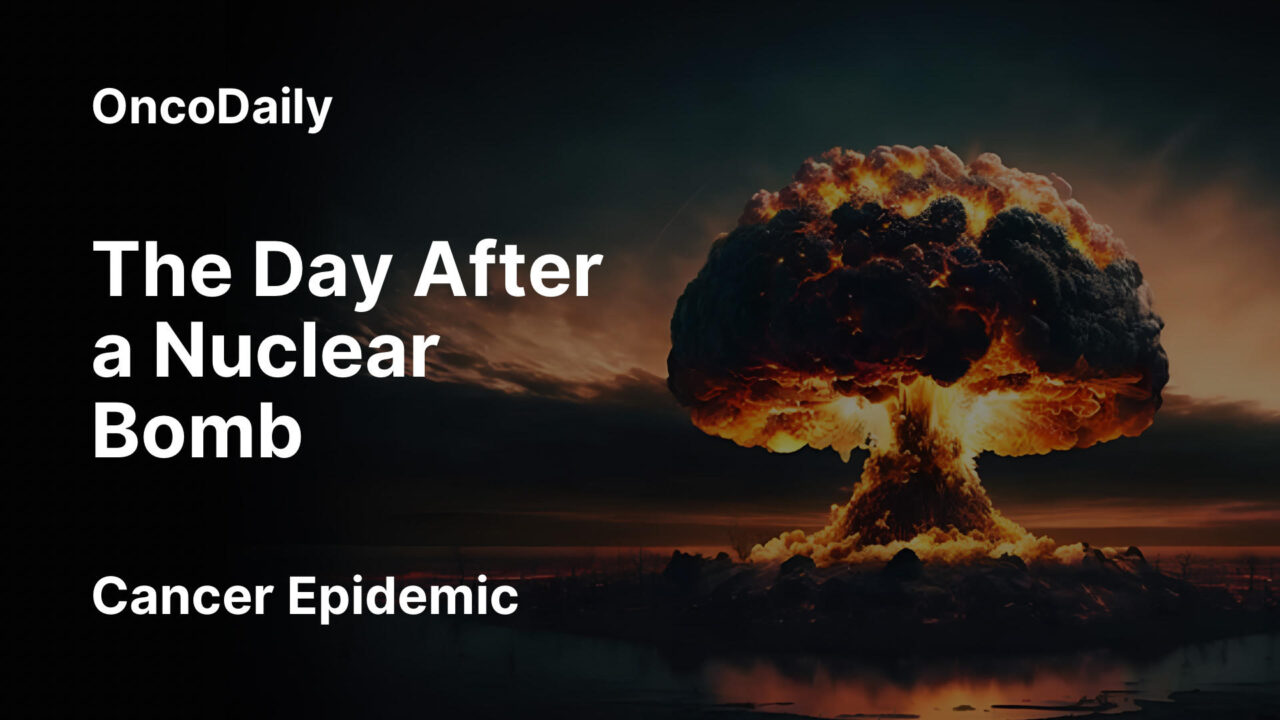
The Day After a Nuclear Bomb: Generational Damage and the Silent Cancer Epidemic
A nuclear bomb explosion unleashes an immense release of energy through blast, heat, and ionizing radiation, causing instant and widespread devastation. The shockwave obliterates buildings and kills most people near ground zero within seconds, while thermal radiation ignites fires and causes severe burns over a large area. Beyond this immediate destruction, nuclear weapons produce intense ionizing radiation that contaminates the environment and poses long-lasting health dangers.
While the blast effects are visible and immediate, the invisible radiation lingers for decades, contaminating soil, water, and air, and spreading radioactive fallout over hundreds of miles. This fallout exposes survivors and neighboring populations to ionizing radiation, significantly increasing their risk of developing cancers such as leukemia, thyroid, lung, breast, and many others. Historical data from Hiroshima and Nagasaki survivors reveal that radiation-induced cancers can appear years to decades after exposure, with children and younger individuals facing the highest risks. Moreover, the health consequences extend beyond the blast zone, affecting future generations through genetic damage.
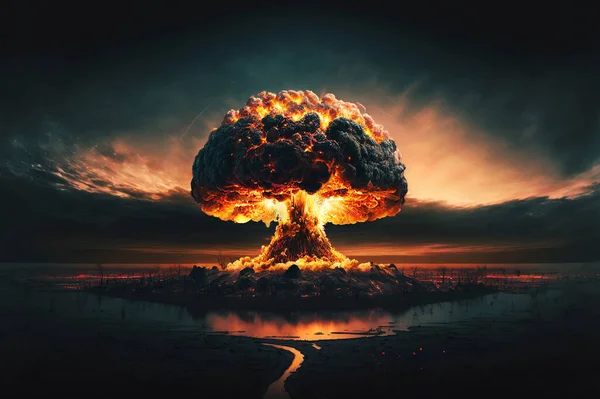
Photo: Depositphotos
This article explores the devastating immediate effects of nuclear explosions and the hidden, long-term cancer risks that threaten survivors and neighboring countries alike, underscoring the urgent need for global nuclear disarmament and prevention.
What Happens During a Nuclear Bomb Detonation?
A nuclear bomb detonation unleashes an immense amount of energy in the form of blast, heat, and radiation, instantly vaporizing everything close to ground zero. Within approximately 10 seconds, the fireball reaches its maximum size, and an enormous shockwave radiates outward at hundreds of kilometers per hour. This blast effect crushes objects, levels large buildings, and causes severe injuries or death from collapsing structures and flying debris.
The intense thermal radiation causes severe burns and ignites widespread fires that can coalesce into a giant firestorm, creating lethal conditions even for those in underground shelters due to lack of oxygen and carbon monoxide poisoning. Millions could die instantly or shortly after a single detonation over a city.

Crucially, an intense burst of nuclear radiation—primarily gamma rays and neutrons—is produced within a fraction of a second of the detonation. This prompt radiation is lethal to living organisms and can extend over a mile from the detonation point. While the immediate visible destruction is catastrophic, this initial, invisible radiation marks the beginning of long-term health dangers that continue to affect survivors and the environment for decades.
How Does Radiation Fallout Spread After a Nuclear Explosion?
When a nuclear bomb explodes, it creates a radioactive cloud containing particles formed from vaporized soil, debris, and fission products. This radioactive material, known as fallout, begins to descend to the ground within minutes to hours after the explosion.
The spread of fallout depends heavily on meteorological conditions such as wind speed and direction, precipitation, and atmospheric stability. Winds can carry radioactive particles hundreds of miles downwind, contaminating vast areas far beyond the blast site. Rain and snow can accelerate the fallout’s deposition, causing localized “hot spots” of intense contamination.
Fallout contaminates soil, water sources, and air, entering the food chain through crops and water supplies. This widespread environmental contamination exposes not only survivors near ground zero but also populations in neighboring and distant regions to harmful ionizing radiation.
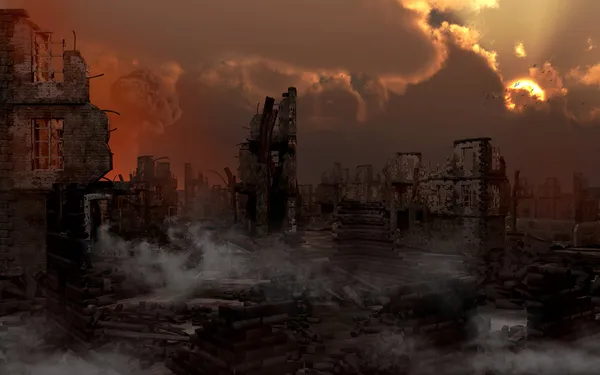
Photo: Depositphotos
The extent and severity of contamination vary with the height of the explosion: surface bursts produce heavier local fallout due to mixing with ground materials, while air bursts tend to disperse radioactive particles more widely but less densely.
What Are the Health Consequences—Including Cancer—After Exposure to Nuclear Fallout?
Exposure to ionizing radiation from a nuclear bomb significantly increases the risk of several cancers. The most commonly linked cancers include:
- Leukemia, particularly acute myeloid leukemia, often appears within a few years after exposure and is one of the earliest radiation-related cancers.
- Thyroid cancer is highly sensitive to radiation, especially due to radioactive iodine exposure, and can develop years after the initial event.
- Lung cancer risk increases due to inhalation of radioactive particles in fallout.
- Breast cancer risk rises, particularly in women and young girls, as breast tissue is sensitive to radiation.
Other cancers linked to radiation include multiple myeloma, bladder, stomach, liver, and esophageal cancers.
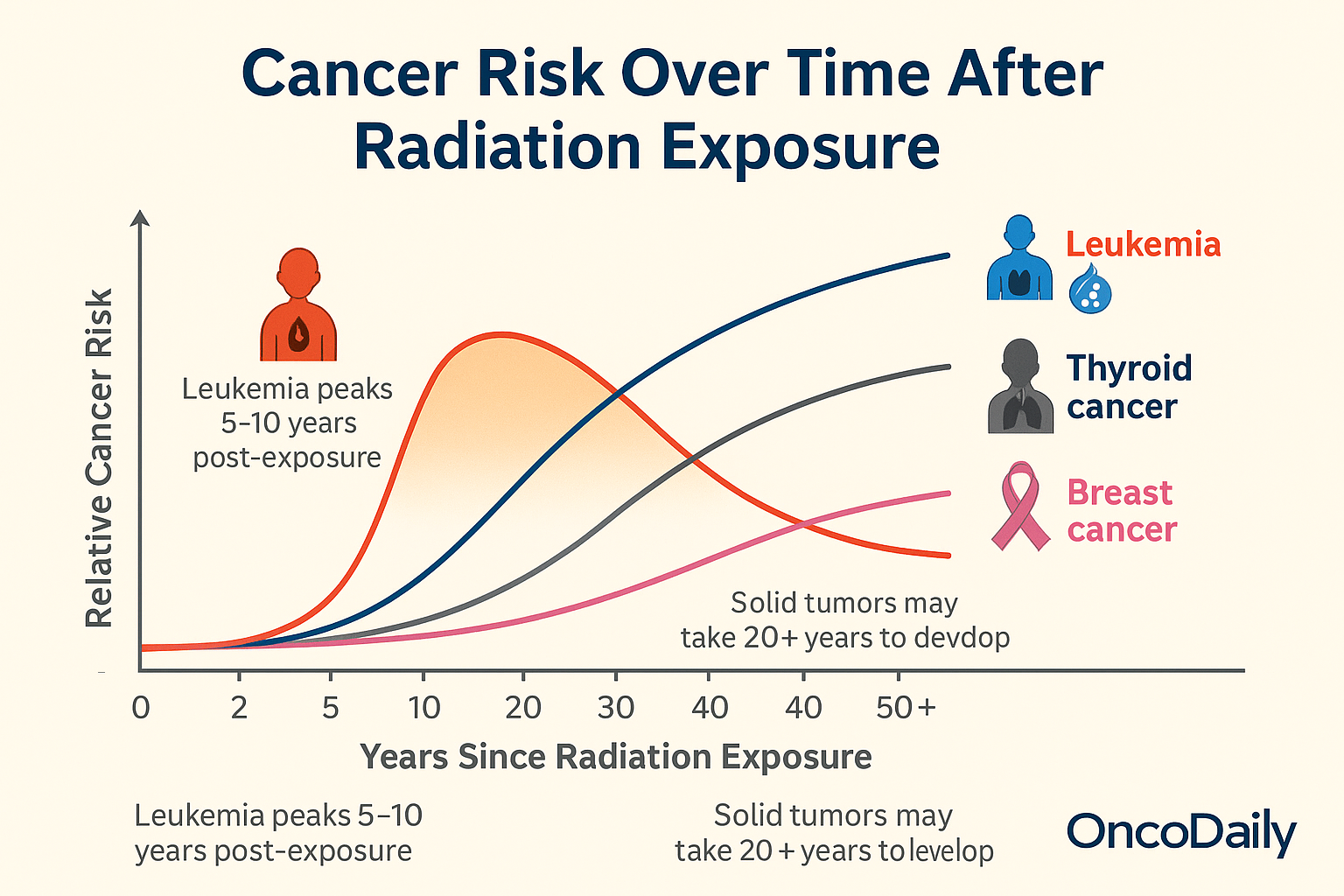
Cancer development after radiation exposure follows a timeline: leukemia cases typically rise 2 to 6 years post-exposure, peaking around 10 years, then decline. Solid tumors such as thyroid, lung, and breast cancers usually take decades to manifest, often 20 years or more after exposure.
Children and those exposed at younger ages face much higher risks because their growing tissues are more vulnerable to radiation damage. Moreover, radiation can cause genetic mutations that affect future generations, leading to birth defects and increased cancer susceptibility in offspring.
These long-term health effects underscore the devastating legacy of nuclear radiation, extending far beyond the initial blast and affecting survivors and their descendants for decades.
How Are Neighboring Countries Impacted by Nuclear Fallout?
Radioactive fallout from a nuclear explosion does not remain confined to the blast site. Winds can carry hazardous radioactive particles hundreds of miles, contaminating soil, water, and air in neighboring regions and even distant countries. This widespread contamination exposes populations far beyond ground zero to dangerous levels of ionizing radiation.
Historical examples and scientific models show that fallout can create “hot spots” of intense radiation, making areas unsafe for years. For instance, atmospheric nuclear tests between 1945 and 1980 have been linked to millions of cancer deaths worldwide due to long-range fallout exposure. Similarly, the Chernobyl disaster contaminated over 20,000 square kilometers across Ukraine and Belarus, causing thousands of thyroid cancer cases, especially in children.
In a hypothetical nuclear attack scenario, neighboring countries downwind could face increased cancer risks, including leukemia and thyroid cancer, due to ingestion of contaminated food and water. Fallout entering the food chain—through crops, livestock, and water—amplifies exposure, affecting both local and distant populations.
Moreover, nuclear war could trigger global climate disruptions, leading to famine and further health crises, disproportionately impacting developing nations and marginalized groups. Medical and disaster response systems in these regions would likely be overwhelmed, exacerbating the long-term health consequences.
These factors highlight that the cancer risks from nuclear fallout extend well beyond the immediate blast area, threatening the health and survival of millions in neighboring countries and around the world.
What Lessons Have We Learned from Hiroshima and Nagasaki?
The atomic bombings of Hiroshima and Nagasaki provide the most comprehensive data on the long-term health effects of nuclear radiation. Studies following survivors over more than 70 years reveal a significant increase in cancer rates linked to radiation exposure.
Research from the Life Span Study cohort shows that solid cancers—including stomach, lung, breast, thyroid, and colon cancers—began to rise about ten years after exposure and continue to increase with age. For survivors exposed to an average dose of 0.2 Gy, cancer risk is approximately 10% higher than normal, while a 1 Gy exposure can increase risk by about 50%. The relationship between radiation dose and cancer risk appears linear, with no safe threshold identified.

A man injured by the dropping of the atomic bomb on Hiroshima shows scars on his back, 1951.
Leukemia was the first cancer observed to spike within five years after exposure, peaking around 10-15 years, especially among children. Childhood survivors also face multiple independent cancers over their lifetimes due to whole-body radiation damage. Despite the passage of decades, many survivors continue to develop radiation-associated cancers, underscoring the persistent nature of radiation’s harm. Medical challenges remain significant, as radiation damages stem cells in multiple organs, leading to complex cancer risks and other non-malignant diseases.
These historical lessons emphasize that the health consequences of nuclear radiation are lifelong and multigenerational, highlighting the urgent need for prevention and preparedness in the face of nuclear threats.
What Are the Medical and Social Challenges After a Nuclear Attack?
A nuclear detonation would instantly overwhelm healthcare systems in the affected city and surrounding regions. Hospitals would face a catastrophic surge of hundreds of thousands to over a million injured people, far exceeding available beds, doctors, nurses, and critical care units. For example, studies show that even major cities with advanced medical infrastructure would have only a tiny fraction of the burn care and ICU beds needed to treat victims with severe radiation burns and trauma.
Beyond the shortage of medical supplies and personnel, essential utilities such as power, water, transportation, and communication would be severely disrupted, crippling the entire healthcare delivery system. This collapse would hinder emergency response, patient isolation, radiation testing, and mass evacuation efforts, compounding the crisis.
The psychological toll on survivors and healthcare workers would be immense. Widespread trauma, grief, and anxiety would strain mental health services, which are ill-prepared for such a disaster. Social disruption would include displacement, food and shelter shortages, and breakdowns in public order, further exacerbating health risks.
Effective response requires extensive advance preparation, including training medical teams in radiation injury management, stockpiling life-saving medications (e.g., antibiotics, blood products, treatments for acute radiation syndrome), and ensuring protective equipment for responders. However, even with preparation, the scale of casualties and infrastructure damage would pose unprecedented challenges to recovery and care.
You Can Also Read Does 5G Mobile Network Cause Cancer? Myths and Facts by Oncodaily
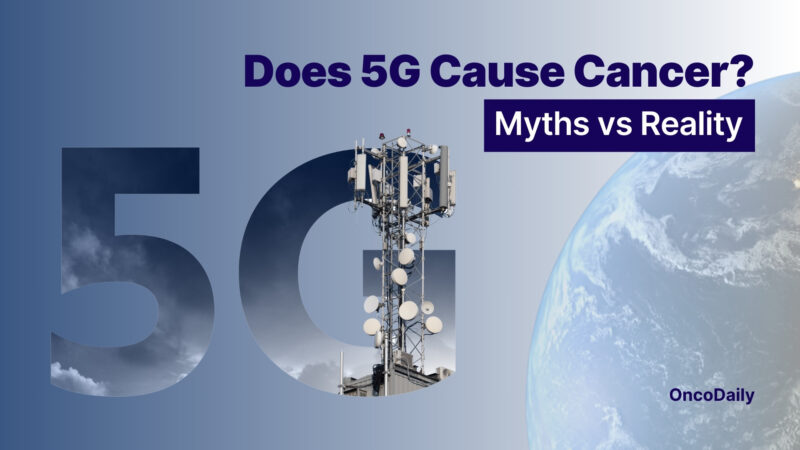
You Can Also Read Lucrezia Bernabucci on Green Radiotherapy and Sustainability in Radiation Therapy | ESTRO 2025 by Oncodaily
Why Is Global Prevention and Nuclear Disarmament Essential?
The threat of nuclear weapons and their catastrophic health impacts, including cancer, underscore the urgent need for global prevention efforts. International treaties play a critical role in reducing nuclear risks and promoting disarmament.
Key agreements like the Treaty on the Non-Proliferation of Nuclear Weapons (NPT), adopted in 1968, aim to prevent the spread of nuclear weapons, promote peaceful nuclear energy, and work toward eventual nuclear disarmament. Nearly 190 countries have joined the NPT, committing to non-proliferation and disarmament negotiations, though challenges remain with some states outside the treaty.
More recently, the Treaty on the Prohibition of Nuclear Weapons (TPNW), which entered into force in 2021, goes further by banning the development, possession, and use of nuclear weapons altogether. While many states have ratified the TPNW, nuclear-armed countries have yet to join, highlighting ongoing geopolitical tensions.
Diplomacy and public awareness are essential in preventing nuclear conflict. Global cooperation, transparency, and civil society advocacy help build pressure for disarmament and reduce the risk of nuclear war. Education on the devastating long-term health consequences, such as radiation-induced cancers affecting survivors and neighboring populations, reinforces the moral imperative to eliminate nuclear weapons.
Ultimately, nuclear disarmament and sustained diplomatic efforts remain humanity’s best defense against the catastrophic cancer and health crises that would follow any nuclear attack.
You Can Also Read Success Rate and Survival After Stereotactic Radiotherapy by Oncodaily

Written by Aharon Tsaturyan MD
FAQ
What is radiation and how does it cause cancer?
Radiation is energy that can damage DNA in cells, potentially leading to cancer by causing mutations.
Can exposure to radiation from nuclear power plants cause cancer?
Routine emissions from nuclear power plants are very low and not lethal; cancer risk from normal operation is minimal.
How does radiation exposure from a nuclear bomb affect health?
Radiation from a nuclear blast causes immediate injuries and long-term effects, including increased cancer risk years later.
What types of cancer are linked to radiation exposure?
Common radiation-related cancers include leukemia, thyroid, lung, breast, and other solid tumors.
How soon after radiation exposure can cancer develop?
Leukemia may appear within 2-6 years, while solid cancers often develop decades later.
Can children and future generations be affected by radiation exposure?
Yes, children are more vulnerable, and genetic damage can increase cancer risk and birth defects in future generations.
Are there treatments or protections against radiation-induced cancer?
Potassium iodide (KI) can protect the thyroid from radioactive iodine; radiation therapy is used to treat cancer but cannot prevent radiation-induced cancer.
Will I be radioactive after radiation therapy or nuclear exposure?
Patients may be temporarily radioactive after nuclear medicine scans; fallout exposure can cause internal and external contamination.
How does radiation therapy kill cancer cells?
Radiation damages cancer cell DNA directly and indirectly, causing cell death through apoptosis, necrosis, or other mechanisms.
What precautions can minimize radiation exposure?
Minimizing time near sources, increasing distance, and using shielding reduce radiation exposure risk.
-
Challenging the Status Quo in Colorectal Cancer 2024
December 6-8, 2024
-
ESMO 2024 Congress
September 13-17, 2024
-
ASCO Annual Meeting
May 30 - June 4, 2024
-
Yvonne Award 2024
May 31, 2024
-
OncoThon 2024, Online
Feb. 15, 2024
-
Global Summit on War & Cancer 2023, Online
Dec. 14-16, 2023
